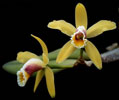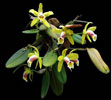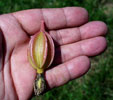|
|
|
|
|
| |
Flasks of
Cattleya luteola 'Natasha' × 'Sable' |
|
| |
|
|
| |
|
|
Click to Enlarge

Pod Parent Flowers |
Click to Enlarge

Pollen Parent Flowers |
Click to Enlarge

Pollen Parent Blooming Plant |
Click to Enlarge

Pollen Parent Capsule at 417 days |
|
|
|
| |
Culture Notes from Donor: Pod parent plant: Will grow well in intermediate conditions (60-83°F) with regular Cattleya light, ample water and fertilizer during the active growing season and less during winter.
Although my plant grows well in my home during the winter months, I suspect it would appreciate a cooler, dryer winter rest than it receives. My plant is mounted and blooms on each new growth. It blooms whenever the new growth matures, although normally this species blooms fall to winter.
Pollen parent plant: Temperature range I (60-83°F)
Comments: This is a miniature unifolate Cattleya endemic to Brazil, Peru, Ecuador and Bolivia. The previous attempt at a selfing of this plant failed so pollen was obtained for the outcross.
Pod parent plant: Some cultivars do not have the red coloration in the throat and side lobes and instead are a nice clear yellow. I think the red color adds considerably to the appeal of the flower.
For additional origin/habitat information supplied courtesy of
Charles and Margaret Baker, see further below, near the bottom of this page.
|
Temperatures we attempt to use in the lab & greenhouse:
| For Species: |
|
Spring, Summer, Autumn, Winter: days average 85°F, nights 66°F; best fit is Warm-Intermediate 87-64°F
(Source:
Baker's Web OSC) |
| For Genus: |
|
Spring, Summer, Autumn, Winter: days average 83°F, nights 60°F; best fit is Intermediate 83-60°F
(
) |
|
About the name...
| Etymology of |
Cattleya |
|
Named in honor of William Cattley, English horticulturist in the 19th century.
(Source:
Pridgeon 1992) |
| Etymology of |
luteola |
|
From Latin "luteolus", yellowish.
(Source:
Hawkes 1978) |
| Pronunciation of |
Cattleya |
|
KAT-lee-ya
(Sources:
Pridgeon 1992, Hawkes 1978) |
| Pronunciation of |
luteola |
|
loo-tee-OH-la
(Source:
Hawkes 1978) |
|
If you would like to direct someone to this web page, please copy and paste this URL into your email:
http://troymeyers.com/d?012501
| Flask Information |
| Availability: |
We have sold all of the flasks for this item. |
| You should: |
Consider getting individual plants or compots instead of a flask.
You can place a "Notify Flask Recipients" Request, and either we or a flask recipient may contact you when plants are available.
You may also place a "Notify Retries" Request, and if an identical pollination (the same parents) is done again, we'll let you know.
You may reserve a flask, but it's very unlikely you'll get one ...this could only happen if we found a flask that we didn't know we had. |
| Yield Estimate: |
360 plants (based on flask surveys done 02/25/2003 )
|
| Plantlet Sizes: |
From many flasks 10 - 20 mm plants (based on flask surveys done 01/02/2004 )
From one most recently surveyed flask 10 - 20 mm (01/02/2004)
|
|
You might also want to:
|
View the seed assay for this item.
View items of the same species.
View items of the same genus.
|
| Ordering Information |
| You are not currently logged in. |
|
You must be a registered user and be logged in to reserve a flask or place a notification request. Please log in:
|
|
|
|
|
|
| |
The origin/habitat information below is supplied courtesy of Charles and Margaret Baker
The following information is based on the name of the plant provided by the donor, and assumes that the name is correct. If the plant has been misidentified, then the following information may not be correct.
This text is copyrighted by the Bakers and may not be reproduced without permission.
ORIGIN/HABITAT: Brazil, Peru, Ecuador, and Bolivia. Plants grow in the
Amazon Basin from west of Manaus, Brazil to the lower eastern slopes of
the Andes west of Iquitos, Peru. Cattleya luteola has spread both north
and south through the eastern foothills of the Andes. Plants are found in
scattered locations in Bolivia and Ecuador. They also have spread onto the
Brazilian Plateau southwest of Manaus. Plants usually grow in relatively
shaded locations on rough-barked trees along rivers in wet, lowland,
tropical forests at 650–2300 ft. (200–700 m).
More about this information and the Bakers...
|
|
|
| |
|
|
|